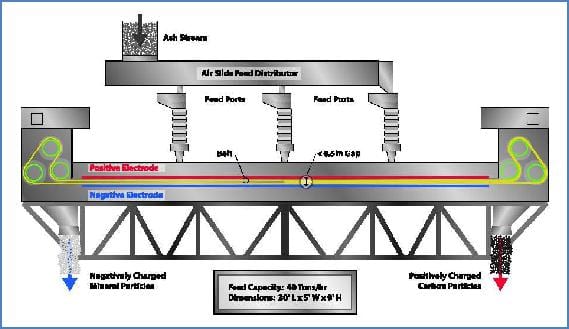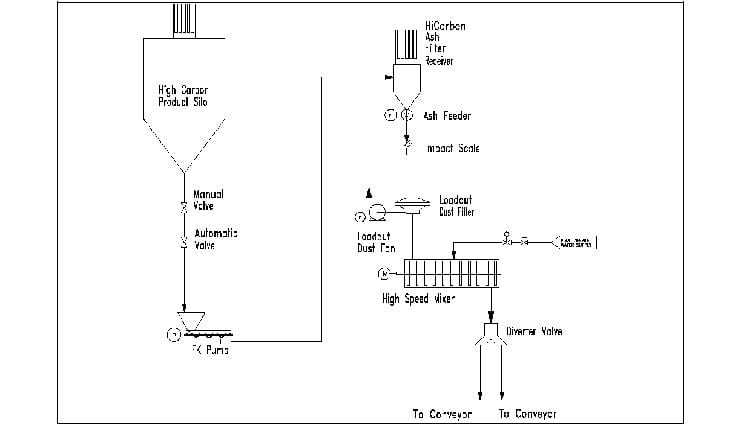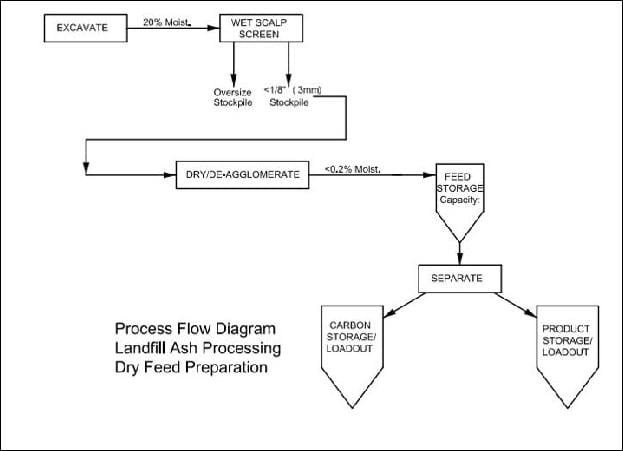Изберете език:
Triboelectrostatic separation has been used for the commercial beneficiation of coal combustion fly ash to produce a low carbon product for use as a cement replacement in concrete for nearly twenty years…. STET’s patented electrostatic separator has been used to produce over 15 Million tonnes of low carbon product…Recent environmental legislation…coupled with a requirement …to empty historical landfill sites, has created the need to develop a process to beneficiate historically landfilled ash…
Изтегляне на PDFTriboelectrostatic Beneficiation of
Land Filled Fly Ash
L. Бейкър, А. Гупта, и S. Gasiorowski
ST оборудване & Технологии LLC, 101 Хамптън авеню, Needham MA 02494 САЩ
CONFERENCE: 2015 Светът на въглища пепел – (www.worldofcoalash.org)
КЛЮЧОВИ ДУМИ: Triboelectrostatic, Обогатяването, Летлива пепел, Landfilled, Dried, Отделяне, Въглероден
АБСТРАКТЕН
Triboelectrostatic separation has been used for the commercial beneficiation of coal combustion fly ash to produce a low carbon product for use as a cement replacement in concrete for nearly twenty years. With 18 separators in 12 coal-fired power plants across the world, ST оборудване & Технологии LLC (STET) patented electrostatic separator has been used to produce over 15 Million tonnes of low carbon product.
To date, commercial beneficiation of fly ash has been performed exclusively on dry “run of station‿ ash. Recent environmental legislation has created, in certain markets, a need to supply beneficiated ash in times of low ash generation. Това, coupled with a requirement in some locations to empty historical ash landfill sites, has created the need to develop a process to beneficiate historically landfilled ash.
Previous studies have shown that the exposure of fly ash to moisture, and subsequent drying influences the triboelectrostatic charging mechanism, with carbon and mineral particles charging in the opposite polarity to that experienced with run of station ash. Studies have been performed by the authors to determine the effect of moisture exposure on separation efficiency of several ashes that have been reclaimed from landfills and dried. Charge reversal was experienced following drying, but overall separation efficiency was achieved equivalent to that experienced with fresh run of station ash.
The effect of dried ash feed relative humidity on triboelectrostatic separation efficiency was examined, and sensitivity was greatly reduced compared to that experienced with run of station ash, lowering overall process costs.
ВЪВЕЖДАНЕТО
На американската въглища пепел асоциация (ACAA) годишно изследване на производството и използването на въглища летлива пепел съобщава, че между 1966 and 2011, над 2.3 billion short tons of fly ash have been produced by coal-fired utility boilers.1 Of this amount approximately 625 милиона тона са били използвани резултатен, най-вече за производство на цимент и бетон. Въпреки това, останалите 1.7+ billion tons are primarily found in landfills or filled ponded
impoundments. While utilization rates for freshly generated fly ash have increased considerably over recent years, with current rates near 45%, приблизително 40 million tons of fly ash continue to be disposed of annually. While utilization rates in Europe have been much higher than in the US, considerable volumes of fly ash have also been stored in landfills and impoundments in some European countries.
Наскоро, interest in recovering this disposed material has increased, partially due to the demand for high-quality fly ash for concrete and cement production during a period of reduced production as coal-fired power generation has decreased in Europe and North America. Concerns about the long-term environmental impact of such landfills are also prompting utilities to find beneficial use applications for this stored ash.
LAND FILLED ASH QUALITY AND REQUIRED BENEFICIATION
While some of this stored fly ash may be suitable for beneficial use as initially excavated, the vast majority will require some processing to meet quality standards for cement or concrete production. Since the material has been typically wetted to enable handling and compaction while avoiding airborne dust generation, drying will probably be a minimal requirement for use in concrete since concrete producers will want to continue the practice of batching fly ash as a dry powder. Въпреки това, assuring the chemical composition of the ash meets specifications, most notably the carbon content measured as loss-on-ignition (LOI), is a greater challenge. As fly ash utilization has increased in the last 20+ години, most “in-spec‿ ash has been beneficially used, and the off-quality ash disposed. Така, LOI reduction will be a requirement for utilizing the vast majority of fly ash recoverable from utility impoundments.
LOI REDUCTION BY TRIBOELECTRIC SEPARATION
While various workers have used combustion techniques and flotation processes for LOI reduction of recovered landfilled and ponded fly ash, ST оборудване & Technologies (STET) has found that its standard processing system, long used for beneficiation of freshly generated fly ash, is equally effective on recovered ash after suitable drying and deagglomeration at lower overall operating costs.
During the ramp-up to commercial application of the STET processing system for fly ash, STET researchers tested the separation of dried landfilled ash. This recovered ash separated very similarly to freshly generated ash with one surprising difference: the particle charging was reversed from that of fresh ash with the carbon charging negative in relation to the mineral.2 Other researchers of electrostatic separation of fly ash carbon have also observed this phenomena.3,4,5

TECHNOLOGY OVERVIEW – FLY ASH CARBON SEPARATION
In the STET carbon separator (Фигура 1), material is fed into the thin gap between two parallel planar electrodes. Частиците се зареждат триоелектрическо чрез контакт между частиците. The positively charged carbon and the negatively charged mineral (in freshly generated ash that has not been wetted and dried) са привлечени от противоположни електроди. The particles are then swept up by a continuous moving belt and conveyed in opposite directions. Коланът премества частиците в съседство с всеки електрод към противоположните краища на. Високата скорост на ремъка също позволява много високи пропускания, до 36 тона на час в един сепаратор. Малката разлика, high voltage field, противотоков поток, vigorous particle-particle agitation and self-cleaning action of the belt on the electrodes are the critical features of the STET separator. Чрез контролиране на различни параметри на процеса, като скорост на ремъка, точка на подаване, и процент на фуражите, процесът на STET произвежда ниска ЛОИ муха пепел при въглеродно съдържание по-малко от 1.5 за да 4.5% from feed fly ashes ranging in LOI from 4% към над 25%.
Фигура. 1 STET Separator
Разделител дизайн е сравнително прост и компактен. Машина, проектирана за обработка 36 тона на час е приблизително 9 м (30 Фута.) дълъг, 1.5 м (5 Фута.) широк, and 2.75 м (9 Фута.) високо. Коланът и свързаните ролки са единствените движещи се части. Електродите са стационарни и съставена от подходящо устойчив материал. The belt is made of non- conductive plastic. The separator’s power consumption is about 1 киловатчас на тон материал, преработен с по-голямата част от мощността, консумирана от два мотора, задвижващи колана.
Процесът е изцяло сух, requires no additional materials other than the fly ash and produces no waste water or air emissions. The recovered materials consist of fly ash reduced in carbon content to levels suitable for use as a pozzolanic admixture in
бетон, and a high carbon fraction useful as fuel. Използването на двата потока продукти 100% решение за отстраняване на проблеми с изхвърлянето на.
RECOVERED FUEL VALUE OF HIGH-CARBON FLY ASH
In addition to the low carbon product for use in concrete, brand named ProAsh®, the STET separation process also recovers otherwise wasted unburned carbon in the form of carbon-rich fly ash, branded EcoTherm™. EcoTherm™ has significant fuel value and can easily be returned to the electric power plant using the STET EcoTherm™ Return system to reduce the coal use at the plant. When EcoTherm™ is burned in the utility boiler, the energy from combustion is converted to high pressure / high temperature steam and then to electricity at the same efficiency as coal, Обикновено 35%. The conversion of the recovered thermal energy to electricity in ST Equipment & Technology LLC EcoTherm™ Return system is two to three times higher than that of the competitive technology where the energy is recovered as low-grade heat in the form of hot water which is circulated to the boiler feed water system. EcoTherm™ is also used as a source of alumina in cement kilns, displacing the more expensive bauxite which is usually transported long distances. Utilizing the high carbon EcoTherm™ ash either at a power plant or a cement kiln, maximizes the energy recovery from the delivered coal, reducing the need to mine and transport additional fuel to the facilities.
STET’s Raven Power Brandon Shores, SMEPA R.D. Мороу, NBP Belledune, RWEnpower Didcot, EDF Energy West Burton, and RWEnpower Aberthaw fly ash plants, all include EcoTherm™ Return systems. The essential components of the system are presented in Figure 2.

Фигура. 2 EcoTherm™ Return system
STET ASH PROCESING FACILITIES
Controlled low LOI fly ash is produced with STET’s technology at twelve power stations throughout the U.S., Канада, the U.K., Полша, and Republic of Korea. ProAsh® fly ash has been approved for use by over twenty state highway authorities, както и много други агенции за. ProAsh® has also been certified under Canadian Standards Association and EN 450:2005 стандарти за качество в Европа. Ash processing facilities using STET technology are listed in Table 1.
Таблица 1. STET Commercial Operations
|
Полезност / Power Station |
Местоположение |
Start of Commercial operations |
Facility Details |
|
Progress Energy – Roxboro Station |
Северна Каролина България |
Sept. 1997 |
2 Сепаратори |
|
Raven Power – Brandon Shores Station |
10000 България |
Април 1999 |
2 Сепаратори 35,000 ton storage dome. Ecotherm™ Return 2008 |
|
ScotAsh (Lafarge / Scottish Power Joint Venture) – Гара Лонганет |
Шотландия Великобритания |
Октомври. 2002 |
1 Разделител |
|
Jacksonville Electric Authority – St. John’s River Power Park,Е-мейл |
Флорида БЪЛГАРИЯ |
Май 2003 |
2 Separators Coal/Petcoke blends Ammonia Removal |
|
South Mississippi Electric Power Authority R.D. Morrow Station |
Мисисипи България |
Януари. 2005 |
1 Separator Ecotherm™ Return |
|
New Brunswick Power Company Belledune Station |
New Brunswick, Канада |
Април 2005 |
1 Separator Coal/Petcoke Blends Ecotherm™ Return |
|
RWE npower Didcot Station |
Англия Великобритания |
Август 2005 |
1 Separator Ecotherm™ Return |
|
PPL Brunner Island Station |
Пенсилвания |
Декември 2006 |
2 Сепаратори 40,000 Ton storage dome |
|
Tampa Electric Co. Big Bend Station |
Флорида БЪЛГАРИЯ |
Април 2008 |
3 Сепаратори, Двоен проход 25,000 Ton storage dome Ammonia Removal |
|
RWE npower Aberthaw Station (Lafarge Cement UK) |
Уелс България |
Септември 2008 |
1 Separator Ammonia Removal Ecotherm™ Return |
|
EDF Energy West Burton Station (Lafarge Cement UK, Cemex) |
Англия Великобритания |
Октомври 2008 |
1 Separator Ecotherm™ Return |
|
ZGP (Лафарж цимент Полша / Сиех Яникосода JV) |
Полша |
Март 2010 |
1 Разделител |
|
Korea South-East Power Yeongheung Units 5&6 |
Южна Корея |
Септември 2014 |
1 Separator Ecotherm™ Return |
COAL ASH RECOVERED FROM LAND FILLS
Two sources of ash were obtained from landfills: sample A from a power plant located in
the United Kingdom and sample B: from the United States. Both these samples consisted of ash from the combustion of bituminous coal by large utility boilers. Due to the intermingling of material in the landfills, no further information is available concerning specific coal source or combustion conditions.

The samples as received by STET contained between 15% and 20% water as is typical for landfilled material. The samples also contained varying amounts of large >1/8 инч (~3 mm) material. To prepare the samples for carbon separation, the large debris was removed by screening and the samples then dried and deagglomerated prior to carbon beneficiation. Various methods for drying/deagglomeration are being evaluated in order to optimize the overall process. A general process flow sheet is presented in Figure 3.
Фигура 3: Process flow sheet
The properties of the prepared samples were well within the range of fly ash obtained directly from normal utility boilers. The most relevant properties for both the separator feeds and products are summarized in Table 2 along with recovered product.
CARBON SEPARATION
Carbon reduction trials using the STET triboelectric belt separator resulted in very good recovery of low LOI product. The interesting phenomena observed was the reversal of charging of the carbon discussed above. While this behavior has been observed previously by STET and other researchers, the mechanism that changes the relative work functions and thus contact charging behavior of the material is not understood. One suggested mechanism is the redistribution of soluble ions on the mineral and

carbon particles, possibly further influenced by the pH of the aqueous solution on the ash4. Whatever the fundamental mechanism is, it does not appear to degrade the practical application of triboelectric separation to reduce the carbon content of the ash.
The properties of the low LOI fly ash recovered using the STET process for both freshly collected ash from the boiler and ash recovered from the landfill is summarized in Table
2.The results show that the STET process efficiency for the recovered landfill ash is within the range expected for ash freshly collected from the utility boiler.
Таблица 2: Properties of feed and recovered low-LOI ash.
|
Feed Sample to Separator |
LOI |
ProAsh LOI® |
ProAsh Fineness, %® +45 µm |
ProAsh® Mass Yield |
EcoTherm® High Carbon Product |
|
Fresh A |
10.2 % |
3.6 % |
23 % |
84 % |
39 % |
|
Landfill A |
9.8 % |
3.3 % |
20 % |
75 % |
28 % |
|
Fresh B |
5.3 % |
2.8 % |
17 % |
91 % |
28 % |
|
Landfill B |
6.9 % |
4.5 % |
24 % |
86 % |
26 % |
PROCESS ECONOMICS
In addition to the normal costs of the STET process, the cost of drying the recovered, high moisture content ash will increase the overall operating costs of the process. Таблица 3 summarizes the fuel costs for both operations in the USA and UK for 15% and 20% moisture contents. Typical inefficiencies of drying are included in the calculated values. Costs are based on the mass of material after drying.
Таблица 3: Drying costs on basis of dried mass.
| Moisture content | Heat Requirement KWhr/t | Drying cost / T dry basis UK | Drying cost / T dry basis US |
|---|---|---|---|
| Gas cost 0.027 £/kWhr | Gas cost $4.75 / mmBtu | ||
| 15 % | 165 | £ 5.24 | £ 1.94 |
| £ 8.48 | £ 3.14 | ||
| £ 6.73 | £ 2.49 | ||
| 20 % | 217 | £ 7.23 | £ 2.71 |
| £ 11.85 | £ 4.39 | ||
| £ 9.40 | £ 3.48 |
ASH CHEMISTRY AND PERFORMANCE IN CONCRETE
The properties of the low carbon ash generated from the dried landfill material were compared to that of freshly obtained ash to check the suitability for use in concrete production. 1.
following table summarizes the chemistry for samples from source B. Testing on source A material has not been completed.
Таблица 4: Ash Chemistry of low LOI ash.
|
Източник Б материал |
SiO2 |
Al2O3 |
Fe2O3 |
Као |
MgO |
K2O |
Na2O |
SO3 |
|
Прясна продукция |
51.60 |
24.70 |
9.9 |
2.22 |
0.85 |
2.19 |
0.28 |
0.09 |
|
Landfilled |
50.40 |
25.00 |
9.3 |
3.04 |
0.85 |
2.41 |
0.21 |
0.11 |
Силата на развитие на 20% заместването на ниско LOI летлива пепел в хаван, съдържащ 600 LB / Юлиян3 показа на материал, получен от депонирани пепел, извършва малко по-добре от материал от производството на пресни. Виж таблицата 5 по-долу.
Таблица 5: Якост на натиск на хоросан кубове.
|
|
7 ден натиск сила PSI |
28 ден натиск сила PSI |
|
Пресни |
3948 |
5185 |
|
Landfilled |
4254 |
5855 |
ЗАКЛЮЧЕНИЯ
След подходящ scalping на големи материали, сушене, and deagglomeration, летлива пепел възстановени от полезност растителна депа може да бъде намалена във въглеродното съдържание, използвайки комерсиализирани STET triboelectric колан разделител. Ефективността на системата на STET е по същество еквивалентни за пепелта, получена прясно от котел операции и сушени депонираните материал. Разделител продукт е подходящ за използване в бетон производство без по-нататъшно обогатяването с почти еднакви експлоатационни качества. The recovery and beneficiation of landfilled ash will provide a continuing supply of high quality ash for concrete producers in spite of the reduced production of “fresh‿ ash as coal-fired utilities reduce generation. Additionally, power plants that need to remove ash from landfills to meet changing environmental regulations will be able to utilize the process to alter a waste product liability into a valuable raw material for concrete producers.
ПРЕПРАТКИ
[1]American Coal Ash Coal Combustion products and Use Statistics: HTTPS://www.acaa-usa.org/Publications/Production-Use-Reports/
[2]ST internal report, Август 1995.
[3]Ли,T.X,. Шафер, J.L., Бан, H., Neathery, J.K., and Stencel, J.M. Dry Beneficiation Processing of Combustion Fly Ash, Proceedings of the DOE Conference on Unburned Carbon on Utility Fly Ash, Май 19 20, Pittsburgh, Ра, 1998.
[4]Baltrus, J.P., Diehl, J.R., Soong, Y., Sands, W. Triboelectrostatic separation of fly ash and charge reversal, Fuel 81, (2002) pp.757-762.
[5]Cangialosi, F., Notarnicola, M., Liberti, L, Stencel, J. The role of weathering on fly ash charge distribution during triboelectrostatic beneficiation, Journal of Hazardous Materials, 164 (2009) pp.683-688.
Word to PDF Converter Converted By BCLTechnologies